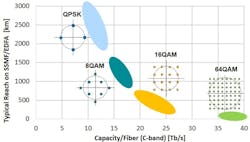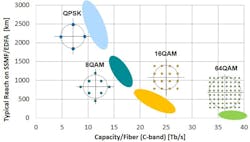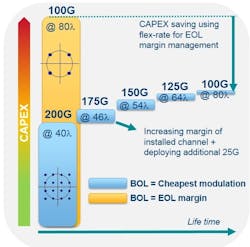Flexi-rate optical interfaces go mainstream
While the evolution of coherent interfaces in optical networks has tried to progress along the lines of historical precedents in wireless technologies, the industry has struggled to find suitable use cases. The first wave of flexible modulation interfaces included 200G 16QAM. While the cost per bit of the line interface could be reduced by 50%, the deterioration in reach was dramatic, leaving the modulation scheme devoid of any significant potential in core and even metro networks.
Only the recent emergence of data center interconnect (DCI) optimized platforms breathed life into 200G 16QAM, which has now found its niche delivering low cost, high capacity inter-city interconnectivity. However, how does the potential of flexi-rate interfaces scale beyond these very static DCI applications? And what are the use cases of flexi-grid in conjunction with flexi-rate?
Flexi-rate goes mainstream
As illustrated in Figure 1, the industry recently marked the arrival of true flexi-rate technology. QPSK/BPSK, 8QAM, and 16QAM formats are now supported in a single digital signal processing (DSP) IC that drives a software-switchable line interface and universal spare covering most reaches. Even higher modulation schemes, such as 64QAM for example, are being explored for lowest cost point-to-point DCI.
In core networks, 8QAM will play a dominant role. This format will address the sweet spot of 1,000 km to 1,500 km in EDFA-based networks, which covers the largest portion of all requirements in long-haul networks, while reducing cost-per-bit versus 100G QPSK.
Conversely, for quite some time 16QAM was positioned as a potential technology for the metro area. However, the naïve thinking that a shorter reach modulation format was all the metro needs proved false. While the metro is primarily about cost, the total cost of ownership is more than the cost-per-bit of the line interface. Other important objectives in the metro – such as a small footprint with low-power DSP ICs, easy serviceability using pluggable interfaces, and in some cases simple network designs with cheap amplifiers and no link control – don't jibe with an overdesigned flexi-rate DSP IC using 16QAM.
Moreover, the intention is often to migrate the customer from a few 10G lambdas to a more cost-competitive coherent solution. However, the optimum cost per bit position of 200G 16QAM requires 20x10G point-to-point traffic, which is not a typical application case in metro networks. Finally, since metro networks are typically more fiber rich than in the core, spectral efficiency is typically a non-factor as well for operators who own their fiber plant.
So why support 200G 16QAM at all? The upcoming availability of 200G 8QAM will put a nail the coffin of 16QAM in green-field national networks using flexi-grid. Carrier networks will see 16QAM as a niche application in small back bone networks assuming it evolves to data rates beyond 200G.
Flexi-rate and flexi-grid
While flexible modulation schemes have been marketed quite aggressively and finally seem to be gaining traction, flexi-grid has been viewed as a requirement that one needed to have, but often without having a clear benefit in mind. The industry has been flooded with 400G, 1T, or 2T super-channel demonstrations, although they were nothing more than a bundling of independent client and line interfaces into a spectral container.
Figure 2 illustrates the two optimal use cases of flexi-grid in an application example of transmitting a total capacity of 4x100G. In the first scenario, flexi-grid is used to increase the spectral efficiency of the fiber by spacing the different wavelengths closer together. As a result, the spectral efficiency can be increased by 33%, delaying a potential deployment of a new overlay network by 1-2 years depending on the capacity growth.
However, operators likely would like to see a cost saving earlier than years down the road. In the second use case, flexi-grid is used to form a superchannel with identical spectral efficiency but higher reach. A better coding scheme that uses more spectrum enables this combination. Thus, the operator can achieve significant "beginning-of-life" (BOL) cost savings using flexi-grid to omit regenerators in network designs or, for example, use 8QAM with better coding instead of QPSK.
Competing technologies for the metro
Transmission at 100G in the metro plays by slightly different rules. Higher-order modulation schemes will eventually arrive in the metro, but not before long-haul and DCI networks. Operationally simple interfaces, such as coherent and direct detect CFPs, have gained a lot of traction, enabling a straight-forward use of opposing line side technologies on the same platform.
Going forward, a four-level modulation scheme (likely PAM4) with direct-detection receivers will gain much momentum for intra-city connectivity. At a fraction of space, power consumption, and cost versus coherent transmission, PAM4 interfaces will be highly competitive versus their coherent counterparts.
The most frequently cited competing direct-detection modulation scheme, Discrete Multi-Tone (DMT), will likely not see much traction in the market, since PAM4 will be the format of choice for mid-board and backplane interconnections, thus giving a straight forward extension driving line side optics.
For coherent interfaces, a future low-power 8QAM approach is best suited to address the higher end of metro requirements, since 16QAM fails to cover most general metro requirements in terms of optical performance (e.g., low supported number of optical nodes in the link, little tolerance to 10G, etc.).
Flexi-rate in the fourth dimension
The previous flexi-rate use cases did not factor in the influence of time. For legacy 10G or 100G interfaces with a single rate, links were designed with respect to a certain end-of-life (EOL) operating margin, which guarantees an error-free operation over 10-15 years. If a system runs out of margin, the interconnectivity would come to a hard stop, and the operator would be required to install regenerators or switch over to new interface technology. Either result would lead to a significant negative impact on the network equipment manufacturer of the failed devices.
Taking in the dimension of time, flexi-rate modulation unveils its beauty and finally closes the mindset gap to fast time-varying wireless channels, which pioneered flexi-rate modulation decades ago. In most aspects, the optical channel can be considered as static – but at greater time scales, effects like component and fiber aging have to be considered.
Figure 3 illustrates a possible scenario. Here, a 200G line rate would be sufficient to operate a link at BOL, while a higher reach and lower capacity 100G rate would be required EOL. Deploying 200G BOL leads to 50% of the required EOL interface number, thus deferring the capital expenditure costs into the future. Let's assume that the capacity can be scaled down in chunks of 25G (as in future FlexEthernet). If the 200G connection runs out of margin, the capacity per interface is scaled down to 175G, and an additional 25G per wavelength are purchased. However, the capital expenditure is a few years out, so that the cost per bit will be much lower due to the cost erosion of the technology in general and a lower net present value of future capital. Extrapolating 10-15 years into the future, a 100G interface capacity can be reached at fractional additional cost compared to the initial investment in 200G.
Flexi-rate and SDN
Just how does flexi-rate play into future optical software-defined networking (SDN) scenarios? The current hype around SDN is primarily driven by data center operators, who are merging their locally distinct locations into a single virtual domain. For a majority of DCI, the optical layer is very simplistic, consisting of point-to-point links with no optical switching. Since these networks lack any form of optical flexibility, the flexi-rate is only required to establish the cheapest BOL connectivity with no in-service reconfigurations.
Once SDN branches out into multiservice meshed networks, this could change. Pre-installed capacity pools could be activated by the customer, in theory, according to demand, reach, and capacity. While the concept works nicely for high-capacity demands, a higher switching intelligence is required to serve the needs of small customers using big pipes. A merging of flexi-rate functionality on Layer 0-1 and switching on Layer 2-3 thus seems inevitable.
Dr. Maxim Kuschnerov is product manager at Coriant.



